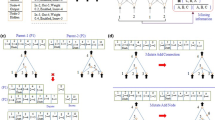Abstract
This study proposes a method to acquire adaptive behavior for artificial creature which has a lot of joints using a combined Artificial Neural Network (ANN). Experiment in this study focuses on artificial fish model, which has a lot of joints, tracking towards a target in the virtual water environment. In order to control motions of joints, a combined ANN is implemented with the model. At first, one ANN is prepared to control specific joints so as to swim basically in response to minimal input information using evolutionary computation in preliminary experiments. And an new network is constructed by combining its network and the other network. In order to acquire complicate behavior for artificial creature, weights of combined ANN are optimized. Experiment result shows the model which has many joints acquire adaptive swimming behavior towards a target by optimizing combined network.










Similar content being viewed by others
Explore related subjects
Discover the latest articles, news and stories from top researchers in related subjects.References
Sims K (1994) Evolving virtual creatures. In: Proceedings of the 21st annual conference on Computer graphics and interactive techniques, pp 15–22
Sims K (1994) Evolving 3D morphology and behavior by competition. Artif Life 1(4):353–372
Chaumont N, Egli R, Adami C (2007) Evolving virtual creatures and catapults. Artif Life 13(2):139–157
Tanev I, Ray T, Buller A (2005) Automated evolutionary design. Robustness, and adaptation of sidewinding locomotion of a simulated snake-like robot. IEEE Trans Robot 21(4):632–645
Nakamura K, Suzuki I, Yamamoto M, Furukawa M (2011) Acquisition of swimming behavior on artificial creature in virtual water environment. Lecture Notes in Computer Science, LNCS/LNAI, vol 5777. Springer, pp 99–106
Stanley KO, Miikkulainen R (2002) Evolving neural networks through augmenting topologies. Evolut Comput 10(2):99–127
Kassahun Y, Sommer G (2005) Efficient reinforcement learning through Evolutionary Acquisition of Neural Topologies. In: Proceedings of the 13th European Symposium on Artificial Neural Networks, pp 259–266
Siebel NT, Sommer G (2007) Evolutionary reinforcement learning of artificial neural networks. Int J Hybrid Intell Syst 4(3):171–183
Yao X (1999) Evolving artificial neural networks. Proc IEEE 87(9):1423–1447
Brooks R (1986) A robust layered control system for a mobile robot. IEEE J Robot Autom 2(1):14–23
Author information
Authors and Affiliations
Corresponding author
About this article
Cite this article
Nakamura, K. Emergence of adaptive behaviors for artificial creature using a combined artificial neural network. Artif Life Robotics 21, 91–97 (2016). https://doi.org/10.1007/s10015-015-0250-9
Received:
Accepted:
Published:
Issue Date:
DOI: https://doi.org/10.1007/s10015-015-0250-9




